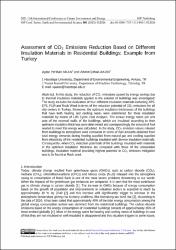| dc.contributor.author | Akan, Aytaç Perihan | |
| dc.contributor.author | Akan, Ahmet Erhan | |
| dc.date.accessioned | 2022-05-11T14:46:50Z | |
| dc.date.available | 2022-05-11T14:46:50Z | |
| dc.date.issued | 2021 | |
| dc.identifier.issn | 1755-1307 | |
| dc.identifier.uri | https://doi.org/10.1088/1755-1315/801/1/012026 | |
| dc.identifier.uri | https://hdl.handle.net/20.500.11776/10378 | |
| dc.description | 2021 11th International Conference on Future Environment and Energy, ICFEE 2021 -- 28 January 2021 through 30 January 2021 -- -- 170060 | en_US |
| dc.description.abstract | In this study, the reduction of CO2 emissions caused by energy savings due to thermal insulation materials applied to the exterior of buildings was investigated. The study includes the evaluation of four different insulation materials including XPS, EPS, PUR and Rock Wool in terms of the reduction potential of CO2 emissions for all city centers in Turkey. Moreover, the optimum insulation thicknesses of the buildings that have both heating and cooling needs were determined for these insulation materials by means of Life Cycle Cost Analysis. The annual energy needs per unit area of the external walls of the buildings, which are insulated according to their optimum insulation thickness were determined and correspondingly the amount of fuel needed to meet this energy was calculated. In the study, CO2 emission values released from buildings to atmosphere were compared in terms of fuel amounts obtained from total energy demands during heating supplied from natural gas and cooling supplied from electricity of the residential buildings insulated with diverse insulation materials. Consequently, when CO2 reduction potentials of the buildings insulated with materials in the optimum insulation thickness are compared with those of the uninsulated buildings, insulation material providing highest potential in CO2 emission mitigation was to be found as Rock wool. © Published under licence by IOP Publishing Ltd. | en_US |
| dc.language.iso | eng | en_US |
| dc.publisher | IOP Publishing Ltd | en_US |
| dc.identifier.doi | 10.1088/1755-1315/801/1/012026 | |
| dc.rights | info:eu-repo/semantics/openAccess | en_US |
| dc.subject | Carbon dioxide | en_US |
| dc.subject | Energy conservation | en_US |
| dc.subject | Housing | en_US |
| dc.subject | Insulating materials | en_US |
| dc.subject | Life cycle | en_US |
| dc.subject | Mineral wool | en_US |
| dc.subject | Wool | en_US |
| dc.subject | Yarn | en_US |
| dc.subject | External walls | en_US |
| dc.subject | Heating and cooling | en_US |
| dc.subject | Insulation materials | en_US |
| dc.subject | Life cycle cost analysis | en_US |
| dc.subject | Optimum insulation thickness | en_US |
| dc.subject | Reduction potential | en_US |
| dc.subject | Residential building | en_US |
| dc.subject | Thermal insulation materials | en_US |
| dc.subject | Thermal insulation | en_US |
| dc.title | Assessment of CO2Emissions Reduction Based on Different Insulation Materials in Residential Buildings: Example from Turkey | en_US |
| dc.type | conferencePaper | en_US |
| dc.relation.ispartof | IOP Conference Series: Earth and Environmental Science | en_US |
| dc.department | Meslek Yüksekokulları, Çorlu Meslek Yüksekokulu, Makine ve Metal Teknolojileri Bölümü | en_US |
| dc.identifier.volume | 801 | en_US |
| dc.identifier.issue | 1 | en_US |
| dc.institutionauthor | Akan, Ahmet Erhan | |
| dc.relation.publicationcategory | Konferans Öğesi - Uluslararası - Kurum Öğretim Elemanı | en_US |
| dc.authorscopusid | 56580128300 | |
| dc.authorscopusid | 57204780394 | |
| dc.identifier.scopus | 2-s2.0-85110488569 | en_US |



















